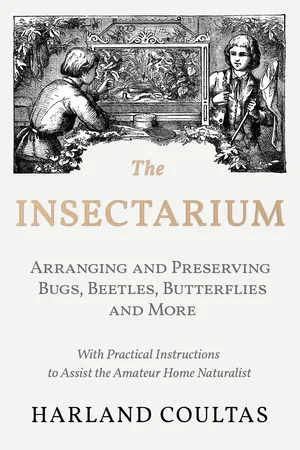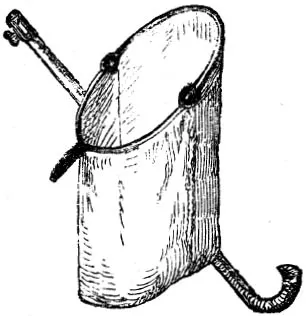
eBook - ePub
The Insectarium - Collecting, Arranging and Preserving Bugs, Beetles, Butterflies and More - With Practical Instructions to Assist the Amateur Home Naturalist
- 32 pages
- English
- ePUB (mobile friendly)
- Available on iOS & Android
eBook - ePub
The Insectarium - Collecting, Arranging and Preserving Bugs, Beetles, Butterflies and More - With Practical Instructions to Assist the Amateur Home Naturalist
About this book
"The Insectarium" is a vintage guide to setting up and maintaining an insectarium, originally written for entomologists and naturalists. An insectarium is an artificial habitat for insects where they can be displayed and studied. They usually contain a variety of insects and similar arthropods, such as spiders, beetles, cockroaches, ants, bees, millipedes, centipedes, crickets, grasshoppers, etc. This volume contains practical tips on creating and maintaining one, as well as information on where and how insects can be captured. Contents include: "The Capture of Insects", "Beetles", "Butterflies and Moths", "Insectarium", "Origin of the Insectarium", "How an Insectarium should be Constructed and Regulated", "Caterpillar Breeding in the Insectarium", "How to Preserve Butterflies in the Insectarium", "Ichneumon Parasites", etc. Many vintage books such as this are increasingly scarce and expensive. It is with this in mind that we are republishing this volume now in a new, affordable, modern edition complete with the original text and artwork.
Frequently asked questions
Yes, you can cancel anytime from the Subscription tab in your account settings on the Perlego website. Your subscription will stay active until the end of your current billing period. Learn how to cancel your subscription.
At the moment all of our mobile-responsive ePub books are available to download via the app. Most of our PDFs are also available to download and we're working on making the final remaining ones downloadable now. Learn more here.
Perlego offers two plans: Essential and Complete
- Essential is ideal for learners and professionals who enjoy exploring a wide range of subjects. Access the Essential Library with 800,000+ trusted titles and best-sellers across business, personal growth, and the humanities. Includes unlimited reading time and Standard Read Aloud voice.
- Complete: Perfect for advanced learners and researchers needing full, unrestricted access. Unlock 1.4M+ books across hundreds of subjects, including academic and specialized titles. The Complete Plan also includes advanced features like Premium Read Aloud and Research Assistant.
We are an online textbook subscription service, where you can get access to an entire online library for less than the price of a single book per month. With over 1 million books across 1000+ topics, we’ve got you covered! Learn more here.
Look out for the read-aloud symbol on your next book to see if you can listen to it. The read-aloud tool reads text aloud for you, highlighting the text as it is being read. You can pause it, speed it up and slow it down. Learn more here.
Yes! You can use the Perlego app on both iOS or Android devices to read anytime, anywhere — even offline. Perfect for commutes or when you’re on the go.
Please note we cannot support devices running on iOS 13 and Android 7 or earlier. Learn more about using the app.
Please note we cannot support devices running on iOS 13 and Android 7 or earlier. Learn more about using the app.
Yes, you can access The Insectarium - Collecting, Arranging and Preserving Bugs, Beetles, Butterflies and More - With Practical Instructions to Assist the Amateur Home Naturalist by Harland Coultas in PDF and/or ePUB format, as well as other popular books in Biological Sciences & Entomology. We have over one million books available in our catalogue for you to explore.
Information


ON THE CAPTURE OF INSECTS.

BEETLES
NOT without reason have many naturalists placed beetles at the head of the insect world, for they exhibit the greatest variety of form, and in the household of nature occupy all conceivable positions and callings. These insects are called in science Coleoptera (from Gr., κολεóς, a sheath, and πτερόν, a wing), because the true membranous wings with which they fly are transversely folded, when in a state of repose, beneath another pair of protecting wings of a hard and horny texture, called elytra (Gr., ἔλυτρον, a covering).
Beetles are the best known and most numerous of all the insect tribes. Their immense numbers, the ease with which they may be preserved, the metallic brilliancy of some of the species, and the interesting habits of others, their singular forms, and the fact that all are harmless, and may therefore be handled with impunity, have won for them the enthusiasm of the collector and the love of the naturalist.
Coleoptera occur in almost every country capable of supporting animal life. Even the ungenial sun of Greenland and Iceland awakens to a short and precarious existence a few small species, which endure, or rather escape from, the rigours of an arctic winter by a kind of hibernation partly analogous to that of some of the vertebrate animals.
Beetles may be found beneath almost any piece of loose moss-covered wall, under any great stone that has been long undisturbed, the deeper sunk in the soil the better; or beneath the moss and lichen covering the trunks of old trees crumbling into decay: such places, carefully examined, will often prove to be the haunts of rare and beautiful species.
In very early spring, before the snow is melted, and when the rays of the sun fall obliquely, so that the earth is only slightly warmed, beetles are alive and active under stones, on grassy mound and heath, or by the wood and meadow pathway. If the stones are turned over in order to surprise them, these active little animals can soon be seized. No boy sharing the kindly feelings inseparable from a true naturalist will, without good and sufficient reason, deprive any creature, however humble, of its life; for all the handiworks of God enjoy the life and powers He has given them, have their part to perform in nature, and are, to a greater or less extent, useful. A beetle or spider running on the ground, or a bee or butterfly on the wing, in diligent search of the honey or pollen of flowers, seeking the food which its Creator has provided for it, or delighting in the pleasure of its existence, will be allowed to pass unmolested, unless it is really wanted as a specimen for the study or a sample for the cabinet. And even then it is incumbent on the young naturalist to employ all care and skill in the painless extinction of life; so as
“Never to blend his pleasure or his pride
With sorrow of the meanest thing that feels.”
Wordsworth.
Beetles as soon as taken should be put into a wide-mouthed phial about 2 1/2 inches high and 1 1/2 inch in diameter, containing spirits of wine, and having a cork stopper, which should be secured to the neck of the bottle by a piece of string or twisted wire. A smaller bottle should be used for smaller insects, which are usually killed by the prussic acid given off by bruised laurel leaves placed in the bottom of the bottle. Sometimes the mouth of the bottle is tightly closed with a cork, through which is passed a quill tube, projecting about an inch below the bottom of the cork. This allows the admission of air when the smaller insects are to be kept alive, and at the same time prevents their escape.

Great and small Beetle-glass.

Tin Box for Beetles.

Collecting Net.
Trees often afford food for beetles, every part of the tree being liable to their attacks. In spring their buds, leaves, and flowers are devoured, and in autumn their fruits. If watched, the woodpecker teaches us where and how beetles are to be found, viz., in the stems of hollow trees; for by his repeated blows on the bark he brings many of them to the surface.
The water has its own peculiar species of Coleoptera,—great and small varieties swimming on the surface or diving below it. After sunset, water-beetles will come to the surface, attracted by the light of a lamp, or even leave the water and fly around it. Small ponds and pools filled with an abundance of water-plants are usually the haunts of different kinds of aquatic beetles, which are easily taken with a dip-net, and are all deserving a place in every collection.
The nets required for catching insects are few, simple, and easily made. The wood-cut on page 3 represents a net commonly used in Germany for the capture of beetles, which is strongly recommended. It consists of a simple sack, made of strong, light linen or cotton, which is sewn over a jointed iron hoop, like a butterfly-net, having a depth equal to twice its diameter. The bottom of a strong walking-stick is provided with a hollow joint, into the thread of which a short screw projecting from the hoop tightly fits. The net can thus be firmly screwed on to the end of the stick. When the hoop is folded at the joint, the mouth of the net is closed. When in use, the net is held open-mouthed under the bushes which are beaten, the insects or larvæ falling into it. The net may also be used to sweep the grass and flowers. When done with, the net is unscrewed from the end of the stick and folded, and both net and stick are easily carried home.
All beetles produce eggs, and undergo a perfect transformation or metamorphosis. From the egg comes a soft-bodied grub or maggot, with a horny head and jaws. The grub in a shorter or longer time changes into a chrysalis, out of which emerges the perfect beetle.
Some beetles appear to have been created expressly to consume unhealthy organized matter, or to effect its removal. Among the beetles thus usefully e...
Table of contents
- Cover
- Title
- Copyright
- Contents
- Section I. On the Capture of Insects.
- Section II. The Insectarium